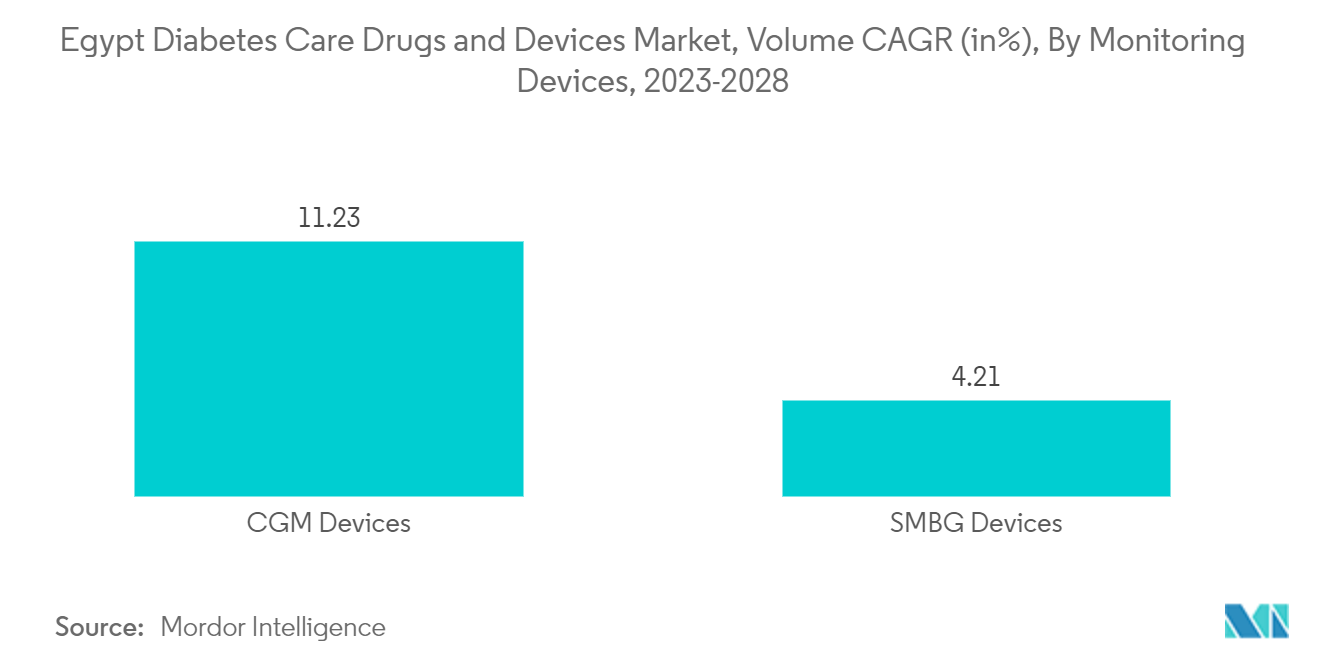Market Trends of Egypt Diabetes Drugs and Devices Industry
The continuous Glucose Monitoring Segment is Expected to Witness the Highest Growth Rate Over the Forecast Period
The continuous blood glucose monitoring segment is projected to grow at a CAGR of around 12% during the forecast period.
CGM is utilized by inserting a diminutive sensor into the abdomen or arm with a low plastic tube known as a cannula penetrating the top layer of skin. A sticky patch holds the sensor in place, letting it take glucose readings in interstitial fluid all day and night. Generally, the detectors need to be replaced in 7 to 14 days. A small, reusable transmitter associated with the sensor lets the scheme forward real-time readings wirelessly to a supervised contrivance that showcases blood glucose information. Several systems come with a committed monitor; several show the data via a smart device app.
Continual glucose observing detectors use glucose oxidase to find blood glucose levels. Glucose oxidase converts glucose to hydrogen peroxidase, which reacts with the platinum inside the sensor, conveying an electrical sign to the transmitter. Sensors are one of the most significant components of continual glucose-observing gadgets. Technological advancements to enhance the precision of the detectors are expected to steer slice development during the forecast period.
The frequency of observing glucose levels depends on the write of diabetes, which varies from patient to patient. Type-1 diabetic patients need to check their blood glucose levels regularly, supervise their blood glucose levels, and adjust the insulin dosing. The common CGM equipment displays an in-depth representation of blood glucose patterns and tendencies compared to daily tasks to check glucose levels at set periods. Furthermore, the common continual glucose observing equipment can retrospectively show the trends in blood glucose levels by downloading the information or giving a real-time characterization of glucose levels over handset showcases.

Rising diabetes prevalence
The main likelihood complied with amongst the Egyptian population is an unwholesome diet, sedentary way of life habits, and a family history of diabetes. The Egypt blood glucose observing industry grew to supervise glycosylated hemoglobin levels. Most diabetic patients in Egypt use blood glucose observing equipment to command blood glucose levels and their fluctuations. Thus, due to the elevated diabetes prevalence and technological adaptation, the industry is developing in Egypt.
In Egypt, the social level has a role in a critical part in patients' entry to vitality concern since the amount of health services centers, hospitals, and pharmacies is tiny in rural areas of interest compared with big cities and urban areas of interest. The financial level is a main determinant of people's entry to vitality care, as the salaries of most of Egypt's employees are insufficient to afford their monthly diabetes provides.
In Egypt, the social level has a role in a critical part in patients' entry to vitality concern since the amount of health services centers, hospitals, and pharmacies is tiny in rural areas of interest compared with big cities and urban areas of interest. The financial level is a main determinant of people's entry to vitality care, as the salaries of most of Egypt's employees are insufficient to afford their monthly diabetes provides. For students and school children with type 1 diabetes, the National Health Insurance System covers insulin, and the student pays nothing for NPH, mixed and short-acting insulins, and only 60% of the price of other types of insulin, which are usually unavailable in the pharmacies of the National Health Insurance System. However, the government is working in the direction of improving the access of patients through various initiatives.


